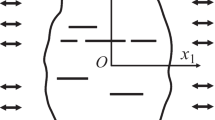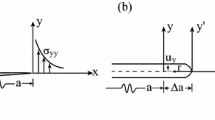Abstract
Fibrous materials often contain cylindrical cracks due to delamination along the matrix-fiber interface. It is instructive to analyse a cylindrical crack of length 2a and diameter 2h in a homogeneous medium and compare the results with those for a pair of parallel cracks of length 2a and spacing 2h. The pair of parallel cracks mutually shielding each other is examined here with regard to the variation of stress intensity factors and energetics including the asymptotic limit of a pair of nearly coalescing parallel cracks. A unified formulation for parallel cracks/cylindrical crack based on crack opening displacement (COD) in terms of Chebyshev polynomials is developed. The characteristic variation of stress intensity factors as the cracks approach each other (h → 0) shows that the stress intensity factors vanish for the case of a vanishingly small cylindrical crack but not for the 2D parallel pair of cracks. The 2D case of a pair of collapsing parallel cracks ensures a finite energy release rate asymptoting to that of a single crack. Further research is needed to establish definitive asymptotic bounds for the case of extremely closely spaced cracks on the lines of Hutchinson and Suo (Adv Appl Mech 29:377–384, 1992), Kachanov (1993) and Gorbatikh et al. (Int J Fract (Lett Fract Micromech) 143:377–384, 2007). Results are presented for different values of Poisson’s ratio.
Similar content being viewed by others
References
Chen YZ, Hasebe N (1992) Stress-intensity factors for curved circular crack in bonded dissimilar materials. Theor Appl Fract Mech 43: 189–196
Chudnovsky A, Kachanov M (1983) Interaction of a crack with a field of microcracks. Int J Eng Sci 21: 1009–1018
Erdogan F, Ozbek T (1969) Stresses in fiber-reinfored composites with imperfect bonding. J Appl Mech 36: 865–869
Farris TN, Kokini K, Demir I (1989) The cylindrical crack. J Appl Mech 56: 981–983
Gorbatikh L, Kachanov M (2007) A simple technique for constructing the full stress and displacement fields in elastic plates with multiple cracks. Eng Fract Mech 66: 51–63
Gorbatikh L, Lomov S, Verpoest I (2007) On stress intensity factors of multiple cracks at small distances. Int J Fract (Lett Fract Micromech) 143: 377–384
Hutchinson JW, Suo Z (1992) Mixed mode cracking in layered materials. Adv Appl Mech 29: 377–384
Itou S (1990) Stresses around a cylindrical interface crack under shear. Eng Fract Mech 36(4): 631–638
Kachanov M, Montagaut ELE (1986) Interaction of a crack with certain microcrack arrays. Eng Fract Mech 25: 625–636
Kachanov M, Montagaut ELE, Laures JP (1990) Mechanics of crack - microcrack interactions. Mech Mater 10: 59–71
Li C, Weng GJ (2001) Dynamic stress intensity factor of a cylindrical interface crack with a functionally graded interlayer. Mech f Mater 33: 325–333
Loehnert S, Belytschko T (2007) Crack shielding and amplification due to multiple cracks interacting with a macro crack. Int J Fract 145: 1–8
Melin S (1983) Why do cracks avoid each other. Int J Fract 23: 37–45
Melin S (1986a) On singular integral equations for kinked cracks. Int J Fract 30: 57–65
Melin S (1986b) When does a crack grow under mode II conditions. Int J Fract 30: 103–114
Morse PM, Feshbach H (1953) Methods of theoretical physics. McGraw Hill
Murakami Y (1987) Stress intensity factors handbook, vol 1. Pergamon Press
Ozbek T, Erdogan F (1969) Some elasticity problems in fiber-reinforced composites with imperfect bonds. Int J Eng Sci 7: 931–946
Prasad PBN, Simha KRY (2004) Disc analogy for approaching circular arc cracks. Int J Fract 125: 51–71
Prasad PBN, Hasebe N, Wang XF (2005) Interaction between interfacial cavity/crack and internal crack -part ii: simulation. J Appl Mech 72: 394–399
Simha KRY, Fourney WL, Barker DB, Dick RD (1986) Dynamic photoelastic investigation of two pressurized cracks approaching one another. Eng Fract Mech 23: 237–249
Simha KRY, Gehlot V, Ramesh M (2008) Multiple crack interactions. In: Interquadrennial conference of international congress on fracture, Bangalore, 3–7 August 2008
Sneddon I N, Lowengrub M (1969) Crack problems in the classical theory of elasticity. Wiley, New York
VanMier JGM (2007) Multi-scale interaction potentials (F-r) for describing fracture of brittle disordered materials like cement and concrete. Int J Fract 143: 41–78
Watson GN (1958) A treatise on the theory of Bessel functions. Cambridge University Press, Cambridge
Williams ML (1959) The stresses around a fault or crack in dissimilar media. Bull Seismol Soc Am 49: 199–204
Yau WF (1967) Axisymmetric slipless indentation of an infinite elastic cylinder. SIAM J Appl Math 15: 219–227
Author information
Authors and Affiliations
Corresponding author
Rights and permissions
About this article
Cite this article
Ramesh, M., Simha, K.R.Y. Cylindrical crack vis a vis parallel crack pair: shielding, energetics and asymptotics. Int J Fract 152, 75–95 (2008). https://doi.org/10.1007/s10704-008-9273-8
Received:
Accepted:
Published:
Issue Date:
DOI: https://doi.org/10.1007/s10704-008-9273-8




